

Reducing susceptibility-induced signal loss in echo planar imaging using a shim insert coil at 7T: Implication for BOLD fMRI Tae Kim 1 , Tiejun Zhao 2 , Yoojin Lee 1 , Piotr Starewicz 3 , Hoby Hetherington 1 , and Jullie Pan 1 1 Radiology, University of Pittsburgh, Pittsburgh, PA, United States, 2 Siemens Medical Solution USA, INC., Siemens MediCare USA, Pittsburgh, PA, United States, 3 Resonance Research Inc., Billerica, MA, United States
Introduction • GE- EPI is commonly used for fMRI studies due to its high sensitivity to BOLD signal changes. • However, GE-EPI acquisitions are also sensitive to the macroscopic local field inhomogeneity, which induces intravoxel dephasing and causes significant signal dropout, especially at high magnetic field. • This signal loss degrades fMRI studies in brain regions adjacent to air cavities, particularly in the ventral prefrontal and lateral temporal lobe, which are important regions in psychiatric studies.
Introduction • Most systems to date are equipped with only 1 st and 2 nd degree shims which are insufficient to correct these susceptibility effects. • The Z-shim method has been proposed to for correct for some of the field distortion. However, this technique reduces the temporal resolution significantly. • To overcome these limitations, higher degree shims (3 rd , 4 th and above) are required. • In this study, we demonstrate the improvement in signal retention using a very high order shim insert coil (2 nd -4 th degree shims) at 7T using GE-EPI acquisitions.
Methods • Four healthy volunteers were studied on a 7-T Siemens scanner using an 8 channel inductively decoupled 1 H transceiver array. • A 28 channel shim insert coil with a 38 cm ID consisting of Z0, all 2nd-4th degree shims and partial 5th and 6th degree shims with 5A shim supplies (Resonance Research Inc.) was used for higher degree/order shimming. B0 mapping was performed using a 6 time point (0.5 to 8ms evolution times) multi-slice measurement. The shim values were calculated using a non-iterative least squares algorithm.
Very High Order Shim Insert
Methods • A single-shot GE-EPI was acquired with FOV = 25.6 × 25.6 cm 2 , matrix size = 96 × 96, slice thickness = 3 mm (voxel size = 2.7 × 2.7 × 3.0 mm 3 ), TR/TE = 2 s/23 ms. • Breath-holds were performed to increase BOLD signal throughout entire brain area. 40 s 40 s 40 s 20 s 20 s • Voxel-wise temporal-signal-to-noise (tSNR) maps were calculated by dividing the mean of the pre-stimulus period by its standard deviation for the sensitivity of GE-EPI • Statistical analyses were performed on a pixel-by-pixel basis (p-value < 0.05) to determine for activated pixels using AFNI. • ROIs were selected by brain parcellation using Freesurfer
Results B0 map Shim 1 st & 2 nd : S.D. = 24.37 Shim 1 st – 4 th : S.D. = 19.24 -50 -50 Hz
T 1 -weighted image with brain extraction
Comparison of GE EPI with 1 st -2 nd and 1 st -4 th degree shimming 1 st & 2 nd 1 st – 4 th 1 st & 2 nd 1 st – 4 th
Comparison of tSNR with 1 st -2 nd and 1 st -4 th degree shimming 1 st & 2 nd 1 st – 4 th 1 st & 2 nd 1 st – 4 th
Comparison of BOLD with 1 st -2 nd and 1 st -4 th degree shimming Subject#1 T: 10 1 st & 2 nd 1 st – 4 th 2 P < 0.05 1 st & 2 nd 1 st – 4 th
Comparison of BOLD with 1 st -2 nd and 1 st -4 th degree shimming Subject#2 T: 10 1 st & 2 nd 1 st – 4 th 2 P < 0.05 1 st & 2 nd 1 st – 4 th
Select ROIs from brain parcellation Orbitofrontal cortex (OFC) Posterior Cingulate (PC) Precuneus (PRE)
tSNR and the number of activation pixel by B0 improvement and Act. pixel improvement Global S.D. tSNR improvement (%) (%) Imprv. Subject (%) 1 st &2 nd 1 st -4 th OFC PC PRE OFC PC PRE 1 28.05 22.04 27.27 6.7 4.33 3.82 29.5 -15.1 -17.7 2 24.37 19.24 26.66 31.1 5.54 -0.64 45.6 -2.53 -3.85 3 26.16 20.4 28.23 62.9 -1.27 12.8 73.3 42.8 39.4 4 23.90 17.61 35.71 16.3 15.3 10.5 -9.43 29.03 8.11 mean 26.62 19.82 29.47 29.26 5.99 6.63 34.73 13.6 6.47
Conclusion • Higher degree/order shim using shim insert coil improves B0 homogeneity. • Consequently, recovered signal by higher order shim increases the number of activated pixels, particularly in orbital frontal cortex. • Our study demonstrates that higher order shimming improves fMRI detection of neural activation, especially in studies of decision making and emotional response at high magnetic field.
Recommend
More recommend